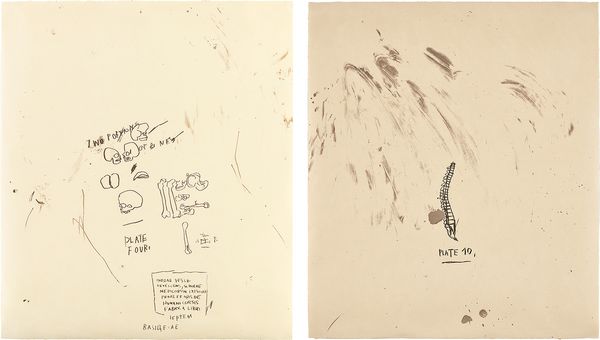Jean-Michel Basquiat, Untitled (Two Portions of Bones) and Untitled (Plate 10) from Untitled: from Leonardo, 1985. Editions & Works on Paper New York.
In early 1980s New York City, a new generation of artists were flourishing in the city’s downtown neighborhoods. Low rents and a freewheeling creative atmosphere allowed this group to thrive in creating work that questioned the prevailing conceptual ideas of uptown art circles.
The Italian-born artist Francesco Clemente, then in his early thirties, moved to the neighborhood around this time, following extensive travels and studies in India. As he later remarked, “To be a painter I needed to be an exile. To be oneself is not that interesting. To be lost in between states of being opens a door. In India, I learned how to think as an artist.” His work from this period often utilized watercolor, pastels, and gauche to explore notions he had considered while studying in India — the fluidity between self and other, mind and body.

Francesco Clemente, Women and Men #13, 1985–1968. Editions & Works on Paper New York.
Jean-Michel Basquiat had made a name for himself through his work with SAMO — a street art partnership he formed with Al Diaz, a childhood friend. In the early ‘80s, when the artist was in his early 20s, his attention shifted from street art to painting and drawing, bringing his already iconic blend of enigmatic symbols, icons, and aphorisms to the art establishment. His meteoric ascent to international stardom was a testament to his ability to brilliantly capture the zeitgeist of the 1980s New York underground scene.
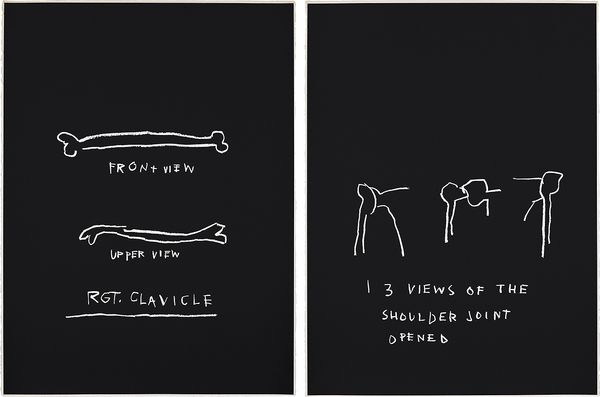
Jean-Michel Basquiat, RGT Clavicle and 3 Views of the Shoulder Joint Opened, from Anatomy, 1982. Editions & Works on Paper New York.
“Jean-Michel knew and respected Clemente, whose studio was only two blocks away from Jean-Michel’s,” wrote gallerist Bruno Bischofberger in 1995. “In the following years he became great friends with him and his wife Alba,” he recalled. Bischofberger, who was close with both artists, had proposed they produce work together with Andy Warhol. This resulted in several collaborative works by Basqiat and Warhol, Basquiat and Clemente, as well as by all three artists.

Andy Warhol, Jean-Michel Basquiat and Francesco Clemente, New York, 1984. Photo: Beth Phillips. © Galerie Bruno Bischofberger.
It all began with a series of conversations the gallerist had with Basquiat in St. Moritz and the project found life in New York. As Bischofberger remembers, “On my next visit to New York I suggested the whole project to Andy Warhol and also to Francesco Clemente. Both found it interesting and surely a new challenge, and soon started on their work.”
A unique opportunity for original screenprints by Basquiat and watercolors by Clemente from this period — available in our upcoming Editions & Works on Paper Auction in New York — presents a fascinating look at each artist’s approach to the human body and anatomy, subjects essential to both of their practices. The works not only showcase each artist’s distinctive sense of form, memory, and self, but also present a compelling look at the creativity of this legendary time and place.
Jean-Michel Basquiat's Anatomy
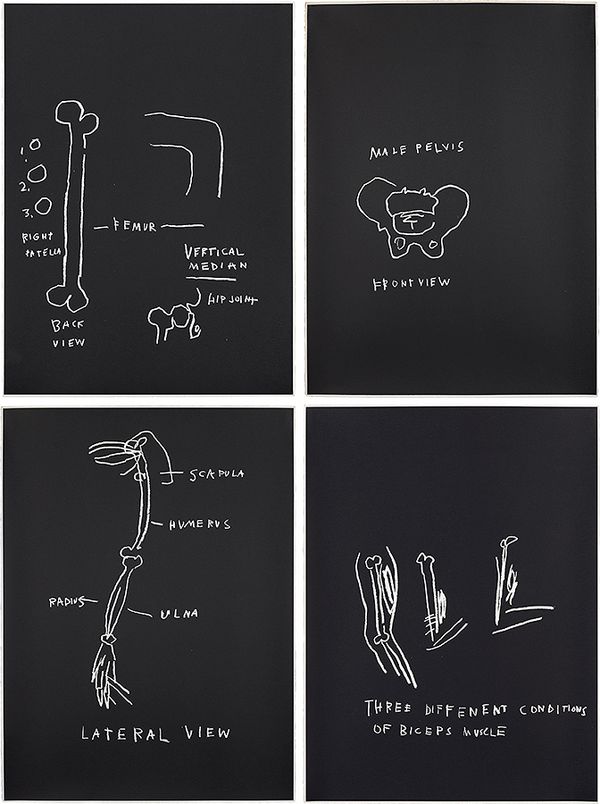
Jean-Michel Basquiat, Femur, Vertical Median; Male Pelvis, Lateral View; and Three Different Conditions of Biceps Muscle, from Anatomy, 1982. Editions & Works on Paper New York.
Basquiat’s interest in anatomy stemmed from an accident in his childhood. In 1968, the seven-year-old Basquiat was hit by a car while playing softball on his street in Brooklyn. The accident resulted in a broken arm and various internal injuries. He later remarked on the experience: “It seemed very dreamlike … it was just like in the movies, where they slow it down when a car’s coming and you. It was just like that.”
During his recovery period in the hospital, his mother gave him a copy of the medical text Gray’s Anatomy, which he pored over and memorized. Filled with detailed anatomical drawings and diagrams, the book had a profound influence on the burgeoning artist who explored fragments of the human body throughout his oeuvre. His fascination with the anatomical realm was crystalized most compellingly in his first experimentation with printmaking, embodied by the two present series Anatomy, 1982 and Untitled: from Leonardo, 1983.

Jean-Michel Basquiat, Anterior View, Right Humerus, Female Pelvis; and Posterior View, from Anatomy, 1982. Editions & Works on Paper New York.
It’s easy to imagine the two artists and friends discussing the present works and their approaches to the human form after long hours in their studios. The environment of the time was complex, however, as Clemente once recalled, “I personally loved Basquiat and Warhol very much. Basquiat worked across the street from my studio. When we would go out at night, I would have to hail a cab for him as cabs would not stop for him, which I found strange.”
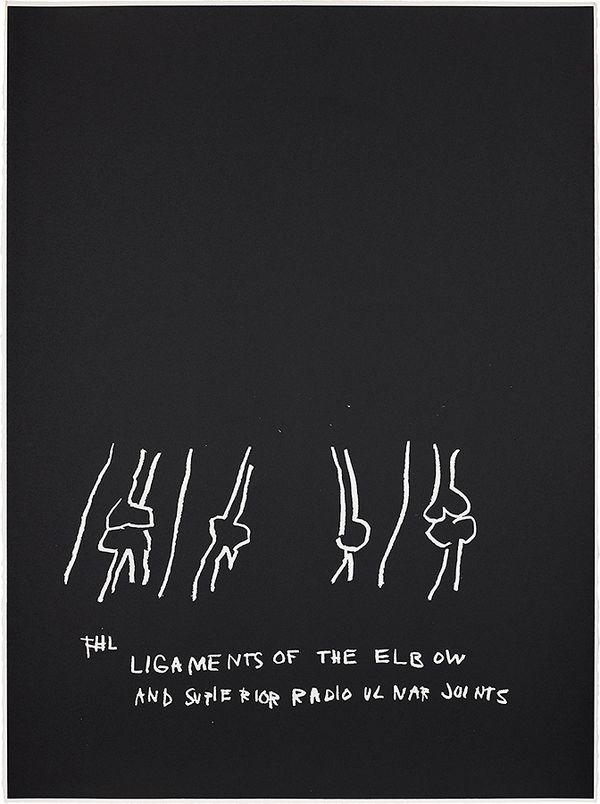
Jean-Michel Basquiat, Ligament of the Elbow, etc., from Anatomy, 1982. Editions & Works on Paper New York.
Francesco Clemente's Women and Men
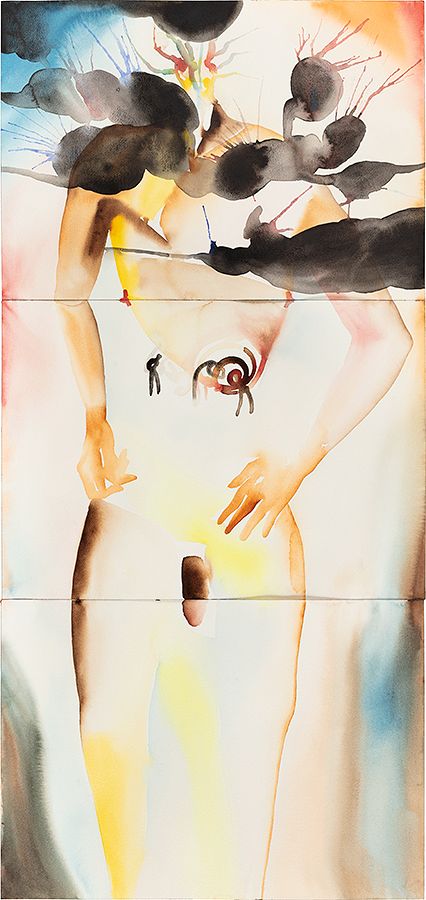
Francesco Clemente, Women and Men #8, 1985–1968. Editions & Works on Paper New York.
In India, Clemente studied Hindu and Buddhist literature as well as Sanskrit, and he learned from Indian papermakers and craftspeople. He arrived in New York City with his mind broadened from his travels and a reverence for the collaborative craftmanship he had experienced in India. He began working on projects in series, as we see here with Women and Men. His works from the time frequently employed watercolor on handmade paper. They explore a sense of mysticism that is executed with a uniquely emotional and lyrical approach, frequently investigating notions of female empowerment and questions of gender identity.
Watercolors are about fluidity and the experience of male verses female is about fluidity. It’s a simple encounter, watercolors, man, woman, and the relentless desire of life to live.
—Francesco Clemente

Francesco Clemente, Women and Men #4, 1985–1968. Editions & Works on Paper New York.
Since arriving in New York, Clemente’s work continues to abound with a sense of spirituality that he first experienced in India. As he once remarked, “America is a mystical place. It may sound paradoxical, but it is a mystical place. The land is a mystical place. If you start walking from New York and go west, the land is so soulful.”
Jean-Michel Basquiat's Untitled: from Leonardo

Jean-Michel Basquiat, Untitled (Plate Ten), Untitled (Teeth), and Untitled (Plate 10), from Untitled: from Leonardo, 1985. Editions & Works on Paper New York.
Fred Hoffman, gallerist and publisher of the Untitled: from Leonardo edition, remembers spending time with Basquiat in these years, frequently watching the artist work in his studio through the night. “During this period, I came to learn of the artist’s interest in the work of Leonardo da Vinci,” Hoffman recalls. “Basquiat mentioned to me that he would be interested in producing a print based on the work of Leonardo. In discussing this idea further, we decided that he would draw on clear acetates, transferring the images photographically to silkscreen and printing on whatever kind of paper he thought appropriate.”
Hoffman then delivered several acetates to the artist. He notes, “About a week later, I noticed that many of the acetates were lying on the floor of the studio, now integrated with sheets of drawing paper, photocopies of drawings, paints and oilsticks, along with music cassettes, cigarette butts and other ‘stuff’ from the artist’s immersion in his studio.”
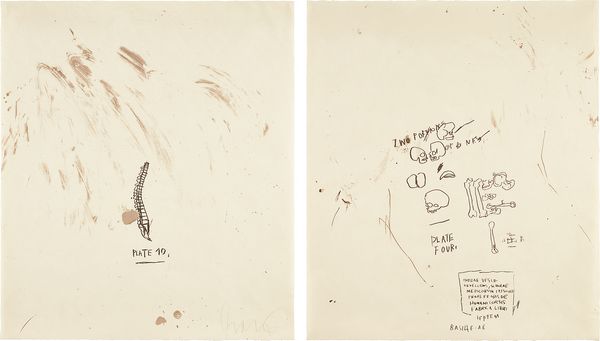
Jean-Michel Basquiat, Untitled (Plate 10) and Untitled (Two Portions of Bones) from Untitled: from Leonardo, 1985. Editions & Works on Paper New York.
Ultimately, this seemingly aloof treatment of the acetate sheets became integral to the final works, as a visit to the studio a short time later demonstrated. “Not only had the artist drawn images and texts on the acetates, but their life on the studio floor had become part of the completed images,” Hoffman explains. “What was totally unexpected was how the random markings resulting from lying on the studio floor would not only complement Basquiat’s drawn images, but would also actually give these works a ‘patina’ — as though they were as old as the sources they referenced.”
Discover More from Editions & Works on Paper New York >
Auction /
Editions & Works on Paper, New York
18 – 20 April 2023
Property from the Collection of Rosa and Aaron Esman, 18 April 11:00am
Evening Sale, 18 April 4:00pm
Day Sale, 19 April 11:00am & 3:00pm
Day Sale, 20 April 1:00pm
432 Park Avenue, New York (map)
Recommended Reading
